Related Research Articles

Ajaccio is the capital and largest city of Corsica, France. It forms a French commune, prefecture of the department of Corse-du-Sud, and head office of the Collectivité territoriale de Corse. It is also the largest settlement on the island. Ajaccio is located on the west coast of the island of Corsica, 210 nautical miles (390 km) southeast of Marseille.

Corte is a commune in the Haute-Corse department, on the island of Corsica, France.

Aiti is a commune in the Haute-Corse department of France on the island of Corsica.

Bonifacio is a commune in the southern tip of the island of Corsica, in the French department of Corse-du-Sud.

Porto-Vecchio is a commune in the French department of Corse-du-Sud, on the island of Corsica.
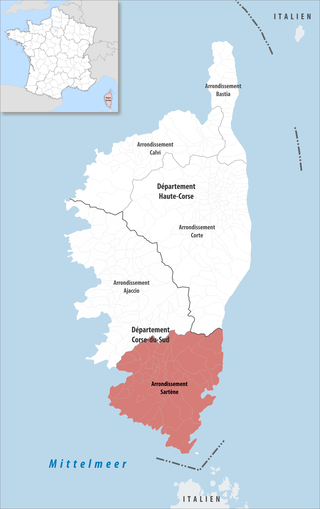
The arrondissement of Sartène is an arrondissement of France in the Corse-du-Sud department in the territorial collectivity of Corsica. It has 43 communes. Its population is 40,830 (2016), and its area is 1,789.9 km2 (691.1 sq mi).

Chemins de fer de la Corse (CFC) is the name of the regional rail network serving the French island of Corsica. It is centred on the town of Ponte Leccia, from which three main lines radiate to Ajaccio, Bastia, and Calvi. The section following the northwest coastline between L'Île-Rousse and Calvi, known as the Balagne line, gives access to many beaches and is very popular with tourists.

Figari is a commune in the French department of Corse-du-Sud on the island of Corsica, France.

Corsica is an island in the Mediterranean Sea and one of the 18 regions of France. It is the fourth-largest island in the Mediterranean and lies southeast of the French mainland, west of the Italian Peninsula and immediately north of the Italian island of Sardinia, the nearest land mass. A single chain of mountains makes up two-thirds of the island. As of January 2024, it had a population of 355,528.

Devil's Bridge is a term applied to dozens of ancient bridges, found primarily in Europe. Most of these bridges are stone or masonry arch bridges and represent a significant technological achievement in ancient architecture. Due to their unusual design, they were an object of fascination and stories in antiquity and medieval Europe.

Asco is a commune in the Haute-Corse department of France on the island of Corsica.

Zonza is a commune in the Corse-du-Sud department of France on the island of Corsica.

Morosaglia is a commune in the Haute-Corse department, on the island of Corsica, France. Since 2015, it is the seat of the canton of Golo-Morosaglia.
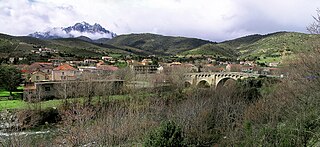
Ponte Leccia is a French village, part of the municipality (commune) of Morosaglia, in the department of Haute-Corse, Corsica. Its name in Corsican language is U Ponte à a Leccia.

Corsica wine is wine made on the Mediterranean island of Corsica. Located 90 km west of Italy, 170 km southeast of France and 11 km north of the island of Sardinia, the island is a territorial collectivity of France, but many of the region's winemaking traditions and its grape varieties are Italian in origin. The region's viticultural history can be traced to the island's settlement by Phoceans traders in 570 BC in what is now the commune of Aléria. In the 18th century, the island came under the control of France. Following the independence of Algeria from French rule, many Algerian Pieds-Noirs immigrated to Corsica and began planting vineyards. Between 1960 and 1976 the vineyard area in Corsica increased fourfold. In 1968, Patrimonio was established as Corsica's first Appellation d'origine contrôlée (AOC). Today, Corsica has nine AOC regions including the island-wide designation Vin de Corse AOC. The majority of the wine exported from Corsica falls under the Vin de pays designation Vin de Pays de l'Île de Beauté. The three leading grape varieties of the region are Nielluccio (Sangiovese), known as the spice wine of France, Sciacarello and Vermentino.
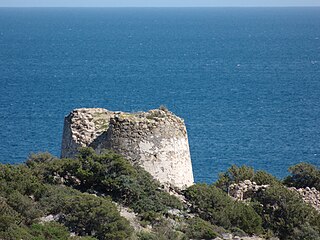
The Tower of Sponsaglia is a ruined Genoese tower located on the border between the communes of Bonifacio, Corse-du-Sud and Porto-Vecchio on the south east coast of the Corsica. Only the round base survives.

The Defensive Organization of Corsica was the French military organization that in 1940 was responsible for the defense of the French island of Corsica against a potential invasion by Fascist Italy. As part of the overall effort to fortify France's borders which included the Maginot Line, the fixed Corsican defenses were constructed in parallel with the Maginot Line, using the same organizational structure and similar designs, albeit scaled back in size, cost and fighting power. The Corsican defenses were designed to deter an Italian landing on the south end of Corsica, and to support artillery batteries capable of controlling the Strait of Bonifacio between Corsica and the Italian island of Sardinia, separated by only twelve kilometers. As World War II unfolded, no attempt was made by Italian forces to mount an opposed landing on Corsica. The island was instead occupied in November 1942. In 1943 Corsica saw fighting when German forces moved from Sardinia. Most of the fortified positions remain to the present day.
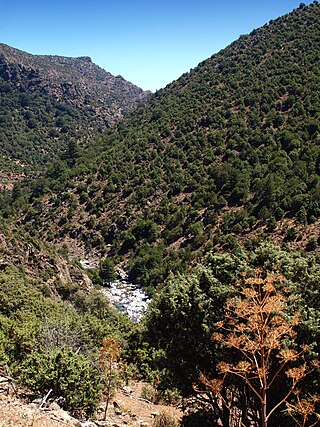
The Asco is a small river in the department of Haute-Corse, Corsica, France. It is a tributary of the Golo. The river rises in the Monte Cinto massif among some of the highest mountains of Corsica, passes a ski resort and the old village of Asco and cuts through a dramatic 4 kilometres (2.5 mi) gorge before joining the Golo.
The Lagunienu is a small coastal stream in the southeast of the department of Corse-du-Sud, Corsica, France.
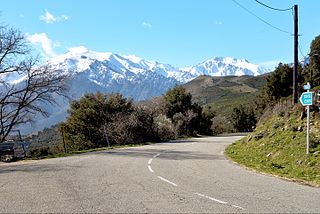
The Col de San Quilico or collo di San Quilico is a mountain pass in the Haute-Corse department of Corsica, France. It is a road pass on Territorial Route 20, between Corte and Ponte Leccia (Morosaglia).
References
- ↑ Today's Railways Europe, #214, pg 23